The Creative Technologist comeback
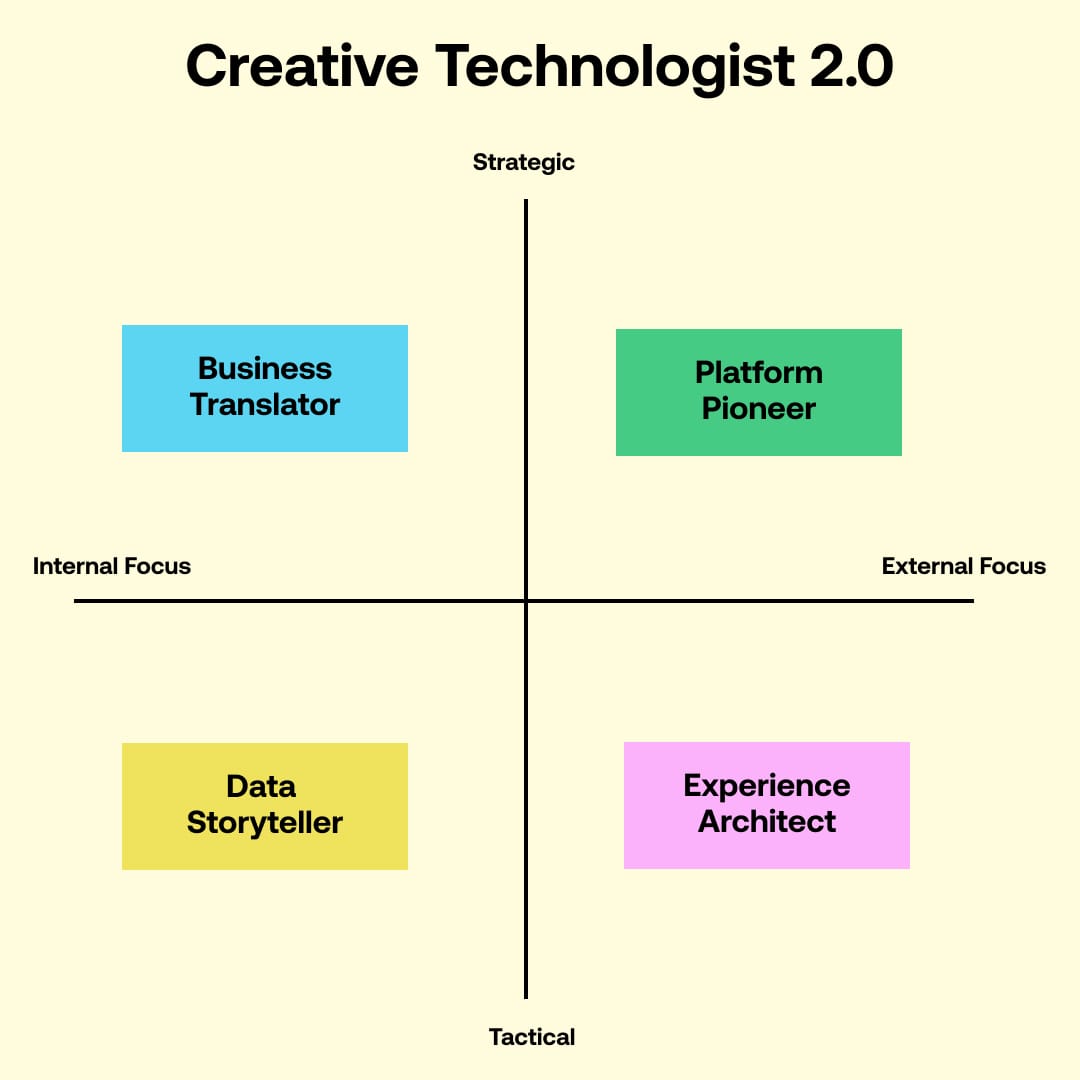
In 2007, I worked at a digital agency in London with someone whose job title was "Creative Technologist". I had absolutely no idea what it meant.
This was during the halcyon days when agencies like AKQA, B-Reel, and Glue London were pushing the boundaries of what digital could be. Interactive Flash experiences were winning Cannes Lions. The web felt experimental and magical.
My colleague lived in this weird liminal space between the creative team and the developers. While the creatives dreamed up concepts and the devs built websites, they made... things. Interactive experiences that were half art installation, half technical demo. Digital experiments that made clients go "wow" and account directors ask "how do we sell this?"
I remember thinking: what the hell even is this job?
The creative technologist spoke in this hybrid language few understood - part creative brief, part code comments. They'd get genuinely excited about ActionScript tweening while the account team stressed about billable hours. The creative directors loved their work but didn't know exactly how it all worked. The developers respected their chops but didn't get why the perfect loading animation mattered so much.
Creative technologists were digital agencies' beautiful misfits. Then, seemingly overnight, the role largely vanished.
The Slow-Motion Crash
The decline started in 2007 when Apple launched the iPhone without Flash support. By 2010, Steve Jobs' infamous "Thoughts on Flash" letter had finished the job.
Suddenly, agencies wanted "mobile-first solutions," not digital art projects. The appetite for beautiful, inexplicable experiences evaporated as clients demanded measurable ROI.
Creative technologists scattered. Some became UX designers, others product managers, many became "design technologists" - essentially the same skill set, repackaged for the startup era. A few experimental experiential agencies (try saying that after a couple of negronis) kept CTs front and centre, but for the most part they went beneath the surface.
Their skills were the drum & bass of digital - once underground, influential, and ahead of their time, but too niche for the mainstream until the culture caught up. By 2015, the term had practically disappeared from job boards.
But the skills didn't die. They just went back underground, waiting for the right moment to resurface.
Fast-forward to 2025. The experimental digital landscape has been replaced by something far more chaotic: the AI gold rush.
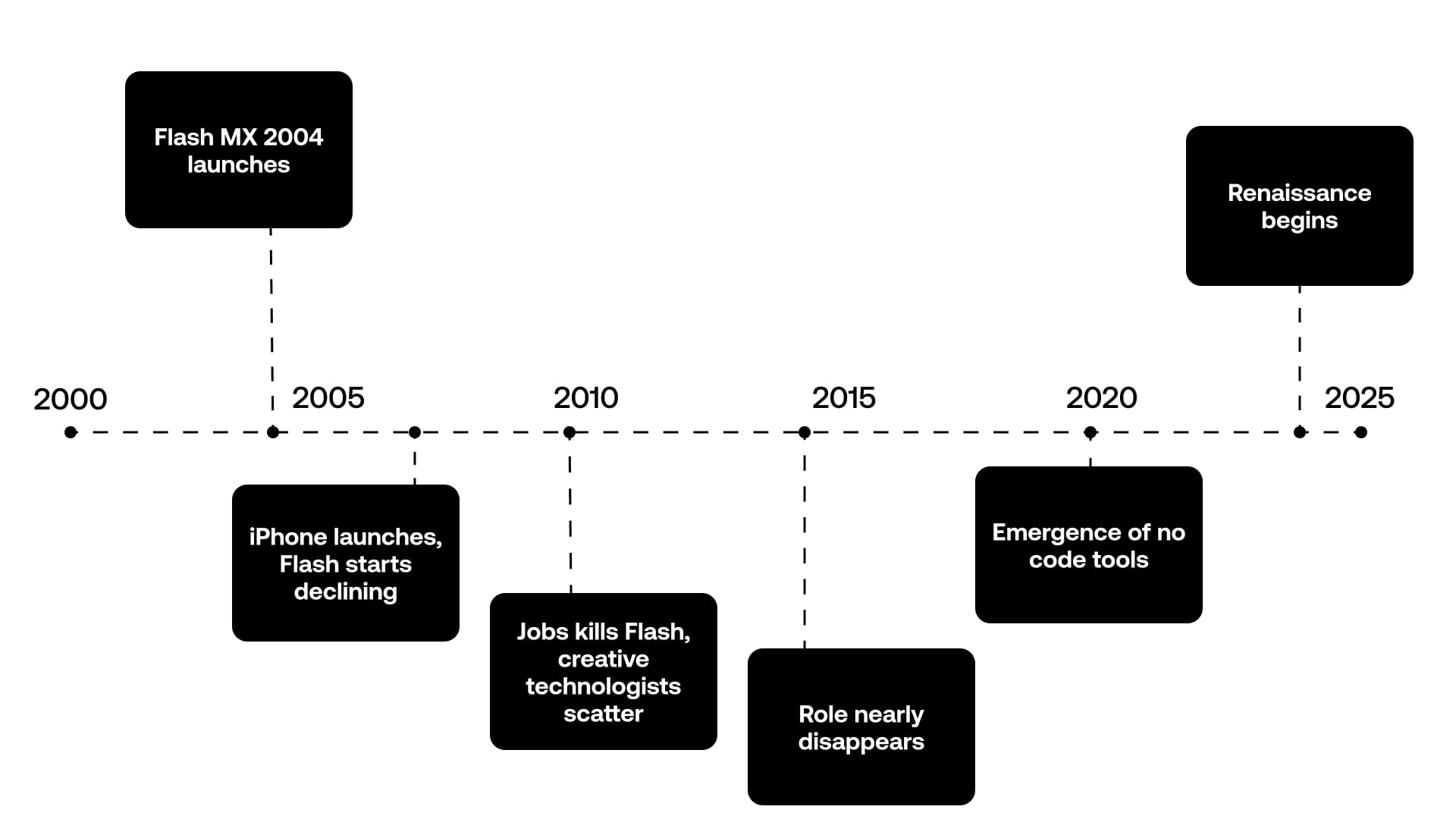
The Signal vs. The Noise
Everyone's pitching AI solutions right now. Every consultant, every agency, every startup founder has suddenly become an "AI expert."
So how do you know who's actually good?
Look for someone who can build working prototypes during your strategy meeting. Not mockups or slide decks - actual functioning experiences you can touch and test.
But in 2025, there's almost no excuse for not being able to build and demonstrate. The tools are too accessible, the APIs too simple. If someone's charging premium rates to advise on AI but can't show you how it works for your specific use case... what exactly are you paying for?
The good ones will ask uncomfortable questions about your business problems before showing you any technology. They'll prototype three different approaches and explain why two probably won't work for your context. They'll build something custom to your world, not a generic AI wrapper with your logo slapped on it.
That's the difference between signal and noise.
The Perfect Storm
Three seismic shifts have created the perfect conditions for the Creative Technologist's return:
AI has democratized coding but elevated creative vision. When anyone can prompt ChatGPT to write basic code, the real value shifts to knowing what to build and why. Creative technologists don't just execute - they imagine possibilities others can't see.
The product/marketing divide has evaporated. Your website is your product. Your product is your marketing. Your brand experience spans seventeen different touchpoints. Companies need people who think holistically, not specialists in silos.
Speed has become the only competitive advantage. Platforms change monthly. Attention spans shrink daily. You need people who can prototype concepts in real-time, not just pontificate about them in PowerPoint.
But here's what's really different: today's creative technologists have learned to speak business. The 2010 version built beautiful experiences that struggled to justify their existence. The 2025 version solves specific business problems while keeping their experimental edge intact.
Four Emerging Archetypes
Despite this demand, the creative technologists I'm seeing fall into four distinct archetypes:
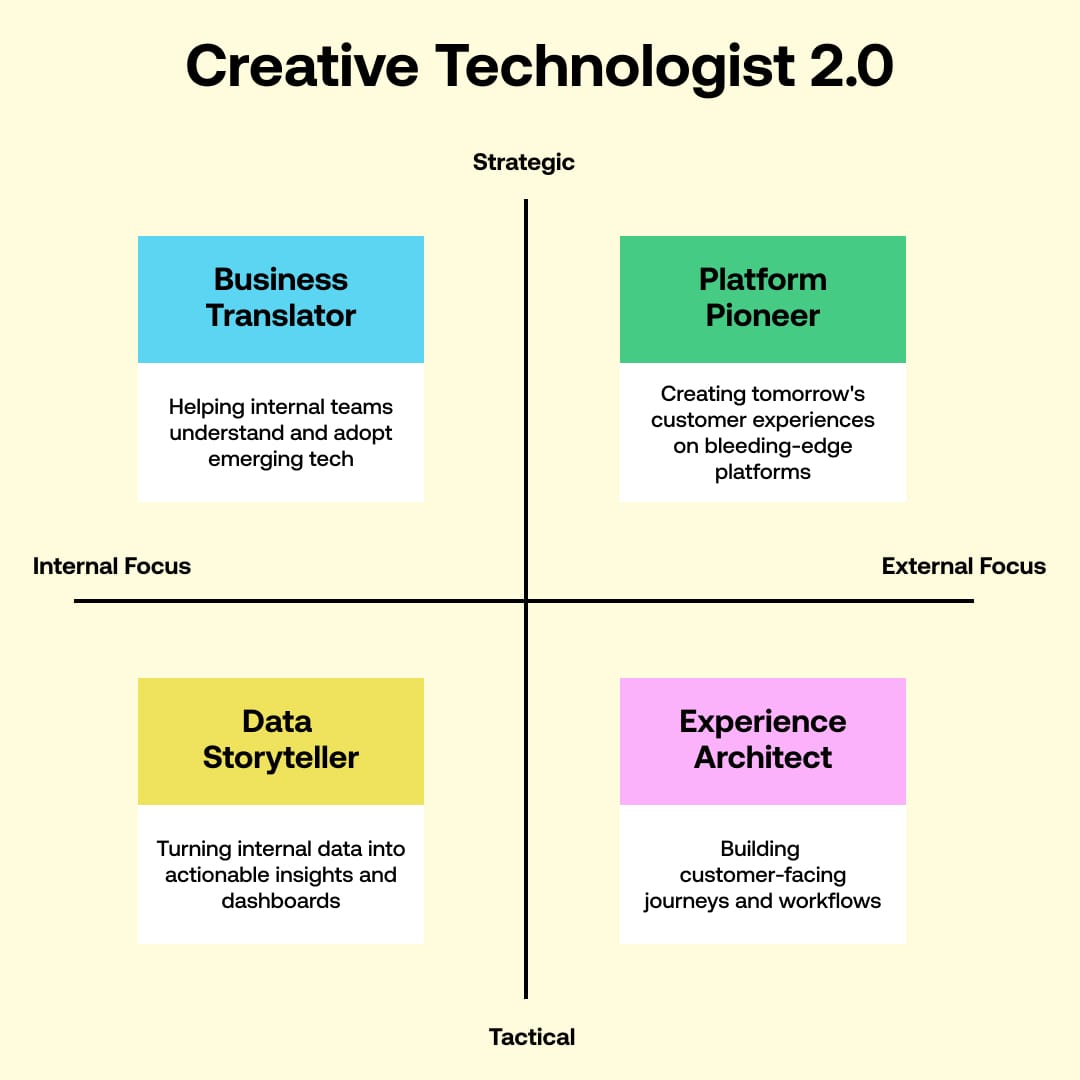
1) The Business Translator
Sits in C-suite meetings and help teams understand what's actually possible with emerging tech. They're educators who can prototype while they explain, making the complex accessible. (I'm one of these - along with a bit of archetype 3...)
Core Skills:
- Workshop design and facilitation
- Business storytelling and communication
- Rapid prototyping with no-code AI tools
- Strategic thinking and pattern recognition
- Cross-functional team enablement
Where they're needed: Strategy consulting, innovation labs, executive advisory, team education and upskilling
Key scenarios: Your leadership doesn't understand how AI could help your business. Your innovation initiatives keep failing because there's no bridge between strategy and execution.
Pairs well with: Strategic CEOs, innovation-hungry board members, transformation-focused consultants
2) The Platform Pioneer
Builds on tomorrow's platforms today. They create the playbook everyone else copies six months later.
Core Skills:
- Advanced creative coding (Three.js, p5.js, TouchDesigner)
- AR/VR development (Unity, Unreal Engine)
- Hardware integration (Arduino, sensors)
- Machine learning implementation
- Physical-digital experience design
Where they're needed: Experience agencies, media companies, cultural institutions, startup R&D teams
Key scenarios: You want to be first to market with AR/voice experiences. Your competitors are creating buzz with cutting-edge digital while you're stuck with traditional approaches.
Pairs well with: Visionary CTOs, experimental marketing directors, forward-thinking creative directors
3) The Experience Architect
Designs end-to-end digital journeys spanning multiple touchpoints. They think in customer flows, not individual channels, and excel at orchestrating complex workflows.
Core Skills:
- Systems thinking and service design
- Multi-platform prototyping
- Data integration and analytics
- Voice/conversational interface design
- Customer journey mapping
- Workflow automation and process optimization
Where they're needed: Product teams, customer experience roles, omnichannel retail, fintech companies
Key scenarios: Your customer journey is fragmented across touchpoints. You're losing customers because your digital experience feels disjointed.
Pairs well with: Savvy COOs, process-obsessed operations leaders, customer-centric CMOs
4) The Data Storyteller
Transforms complex datasets into compelling narratives and interactive experiences. They bridge the gap between what the data says and what humans can actually understand and act on.
Core Skills:
- Advanced data visualization (D3.js, Tableau, custom dashboards)
- AI model interpretation and explanation
- Interactive narrative design
- Statistical analysis and pattern recognition
- User research and behavioral psychology
- Real-time data integration and automation
Where they're needed: Analytics teams, research organizations, fintech companies, healthcare systems, government agencies
Key scenarios: Your data team produces insights nobody acts on. Your AI models are black boxes that executives don't trust. Your dashboards are technically accurate but strategically useless.
Pairs well with: Data-driven CMOs, research-focused CPOs, metrics-obsessed VPs, evidence-based executives
Want practical guidance on integrating AI tools into your creative workflows without losing your human edge? I can help.
The skills exist, but the positioning doesn't
The reality is more nuanced.Search 'Creative Technologist' on LinkedIn and you'll find the role buried among medical technologist positions and rebranded as everything else - 'Design Technologist,' 'Innovation Consultant,' 'Technical Product Manager.' The skills exist, but the title hasn't unified around what they're actually doing.
Which creates a massive positioning opportunity. While everyone fights to be "AI Consultant #47,385," someone could own the space where creativity and technology actually intersect to drive business results.
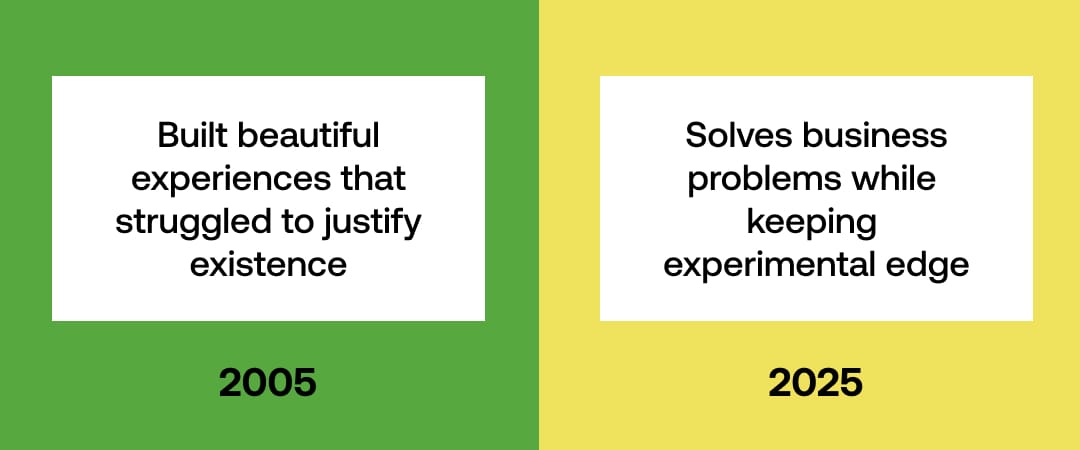
The Uncomfortable Truth
Most "digital transformation" initiatives fail because companies hire people who can pontificate about AI but can't build a working chatbot. They get consultants crafting beautiful narratives while charging $300/hour to explain why their prototype will be ready "next quarter."
Meanwhile, some indie hacker just launched an AI tool that solves the same problem and has 25,000 users within a week.
This disconnect between talking and building hits close to home for me. My degree in multimedia production - which felt embarrassingly unfocused in 2004 - was accidentally perfect preparation. Turns out being scattered across multiple disciplines isn't academic ADHD, it's exactly what you need when the future keeps shifting every six months.
That "wtf what even is this" moment I had in 2007? Companies are having it again.
Except this time, they're not scratching their heads - they're scrambling to find someone who can actually build the future, not just talk about it. At least, they should be.
Here's the thing: for companies, this means rethinking how you hire for digital transformation. Stop looking for 'AI consultants' who can't build. Start looking for creative technologists who prototype while they strategize. The question isn't whether you need these hybrid skills - it's whether you'll find them before your competitors do.
The creative technologist is back. The question isn't whether you need these hybrid skills - it's whether you'll find them before your competitors do.
Want practical guidance on integrating AI tools into your creative workflows without losing your human edge? I can help.
No spam, no sharing to third party. Only you and me.
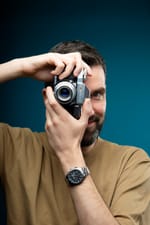
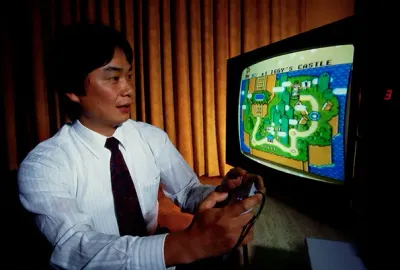

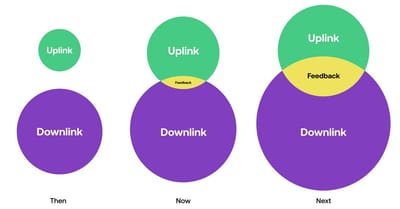

Member discussion